It's all about the classical music composers and their works from the last 400 years and much more about music. Hier erfahren Sie alles über die klassischen Komponisten und ihre Meisterwerke der letzten vierhundert Jahre und vieles mehr über Klassische Musik.
Total Pageviews
Friday, June 3, 2022
Frederick Delius - Song of Summer
Night and Day and Delius
by Maureen Buja , Interlude
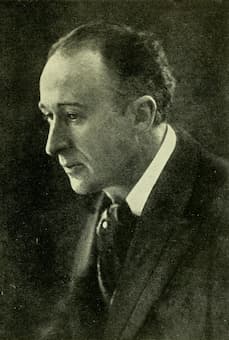
Frederick Delius (1907)
Two works written in close proximity give us two different times of day. Frederick Delius (1862-1934) was a quiet master of the tone poem. Summer Night on the River (1912) is part 2 of his Two Pieces for Small Orchestra (part 1 is On Hearing the First Cuckoo in Spring) and conveys us to a quiet night scene. The river flows by, with occasional leaves or flowers, on the sound of woodwinds. In its quietness and need for dynamic shading, it’s regarded as one of the most difficult of Delius’ scores to perform.
His tone painting is done at a whisper, with small colours appearing in the shadows to the side and just catching your ear as they disappear. It takes all the colours of the day and begins to dilute them.
The matching piece, A Song Before Sunrise, was written in 1918. From the beginning, with his marking of “Freshly” instead of a more traditional tempo marking, Delius has given us the clue to the potential of the day. The rhythm carries us forward and releases us into our new dawn.
Delius was master of the miniature tone poem. These two works, just 7 and 5 minutes long, capture in their sound times of the day that are so elusive. A summer night can be one of a perfect temperature, and when sitting by the river and watching the light so gradually fail, it can be a magical time, as captured by Delius. Before sunrise, on the other hand, is all about potential and what the day can become.
Dream a bit with Delius – his aesthetics are of the most delicate colours and feelings.
Thursday, June 2, 2022
From Children’s Tales to Scenes from Childhood
by Maureen Buja , Interlude
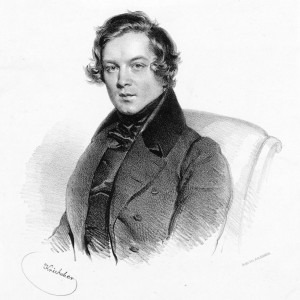
Robert Schumann, lithograph by Josef Kriehuber, 1839
Originally, Kinderszenen, Op. 15 was to be published together with the 8 Noveletten, Op. 21, as a work called Kindergeschichten (Children’s Tales) but Schmann changed his mind and separated them. In a 1838 letter to Clara when he sent her the pieces, Robert wrote that they were an answer to her comment ‘that sometimes I seemed to you like a child….’ He told her to laugh at the titles but to take their performance seriously: ‘They will amuse you, but you will have to forget yourself as a virtuoso.’
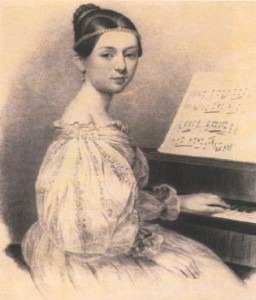
Clara Wieck at the paino
No. 1. Von fremden Landern und Menschen (Of Foreign Lands and People)
No. 2. Curiose Geschichte (A Strange Story)
No. 3. Hasche-Mann (Catch-as-catch-can)
No. 4. Bittendes Kind (Pleading Child)
No. 5. Glückes genug (Happy Enough)
No. 6. Wichtige Begebenheit (An Important Event)
No. 7. Träumerei (Dreaming)
No. 8. Am Camin (By the Fire-side)
No. 9. Ritter vom Steckenpferd (Knight of the Hobby-horse)
No. 10. Fast zu ernst (Almost Too Serious)
No. 11. Furchtenmachen (Frightening)
No. 12. Kind im Einschlummern (Child Falling Asleep)
No. 13. Der Dichter spricht (The Poet Speaks)
But this is a land as observed by an adult and observed from a distance. The opening piece, Of Foreign Lands and People, serves as the key to the work, with its opening theme appearing in various guises throughout the other pieces.
If we listen to the same piece in other hands, we can hear how much interpretation can change the work.
Brendel’s vision seems much more dutiful than the world of the imagination summoned by Argerich.
The best known of the 13 pieces is the middle one: No. 7, Traumerei (Dreaming). Every child who learns to play it thinks he’s gotten a vision into the world of Schumann, but in the hands of a virtuoso, the role of rubato (a slight speeding up and slowing down of the tempo) gives us a much more dreamlike quality to the work.
Overally, the pieces are not technically demanding, but it is the quality of expression and the sensitivity of the performer to that expression that is key. It is important to remember that the titles are not the story, but only an indication meant to guide the performer. When we look at the final piece, No. 13, The Poet Speaks, we can finally see that these Scenes from Childhood are not scenes as seen by a child, but scenes as remembered by ‘The Poet,’ and therein lies the difference.
Wednesday, June 1, 2022
Best Songs in D Minor
by Hermione Lai , Interlude
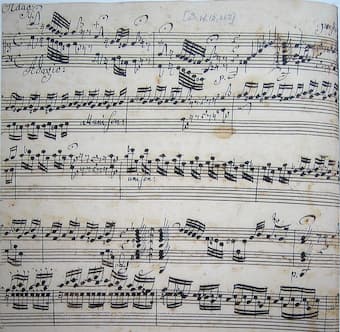
Bach’s Toccata in D minor 18th century copy by Johannes Ringk
Sometimes, I really don’t understand the descriptions assigned to particular keys. When it comes to D minor, we can read that it represents “dejected womanhood which broods on notions and illusions.” I guess it’s a pretty fancy and period description of a scorned woman in love? Others have said that D minor “expresses a subdued feeling of melancholy, grief, anxiety, and solemnity.” Whatever the case may be, some of the most famous and popular classical pieces ever are written in D minor. And here is my list of personal bests.
Bach: Toccata and Fugue in D minor
I can tell you that it was not a very easy choice because of all the gorgeous compositions in D minor that I have to leave out. However, for me it’s all starting with the Toccata and Fugue in D minor by Johann Sebastian Bach. Today that song is used in a variety of popular media, ranging from film, video games and ringtones. But the association today is not melancholy or a scorned woman in love, but sheer terror. This association with horror and Halloween first appeared in a 1962 film adaptation of “The Phantom of the Opera.” It just goes to show that specific associations are easily formed in connection with visual media, but the D minor Toccata and Fugue is still a most powerful composition, and certainly one of the best songs in D minor.
Mendelssohn: Piano Trio No. 1 in D minor
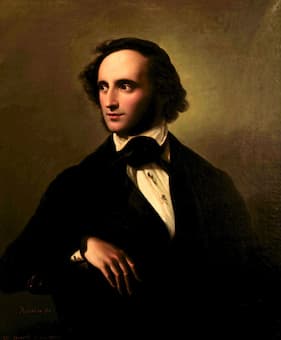
Portrait of Felix Mendelssohn by Wilhelm Hensel, 1847
Felix Mendelssohn learned a lot from the music of Bach. In fact, he was responsible that the music of Bach found its rightful place on the world’s concert stages. Mendelssohn looked at the styles and compositional techniques of the past and developed a highly personalized music style. Not everybody was enthusiastic for Mendelssohn to go back in time, and Berlioz once said, “Mendelssohn paid too much attention to the music of the dead.” And the always-punchy critic and playwright George Bernard Shaw compared Mendelssohn to a senile academy professor whose exercises in a dead musical language “are as trivial as they are tedious.” Then as now, it’s difficult to please the critics. Mendelssohn complete his piano trio in D minor in 1839, and Robert Schumann wrote in his review that “Mendelssohn is the Mozart of the 19th century, the most illuminating of musicians.” There is a good bit of melancholy yearning in the opening movement, and the slow “Andante” is actually a song without words that turns to passion. The scherzo is light and airy, and it all ends with a passionate rondo. For me personally, this is one of the most powerful and best songs in D minor ever.
Mozart: Requiem
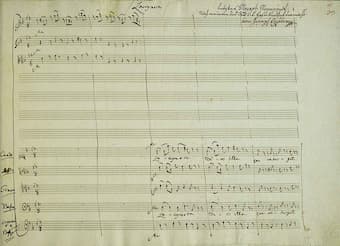
Mozart’s Requiem
Since the key of D minor is supposed to express grief and solemnity, it’s not surprising to find a good number of Requiems in that category. Composers who have written Requiems include Bruckner, Reger, Fauré, and probably most famously, Wolfgang Amadeus Mozart. The passionate lover of music, Count Franz von Walsegg commissioned the work for his twenty-year old wife Anna, who had sadly passed away.
The Count was a fellow Freemason, but as we all know, Mozart himself died before he could complete the composition. Sorry to disappoint all fans of the movie Amadeus, but Salieri had nothing to do with the Requiem or with Mozart’s death. Mozart’s wife Constanze hired several composers to finish the piece and deliver it to the Count. Constanze did suggest that her husband actually believed that he was writing the requiem for his own funeral. Whatever the case may be, it is one of the most powerful classical compositions I know, and it certainly is one of the best songs in D minor.
Haydn: Symphony No. 80 in D minor
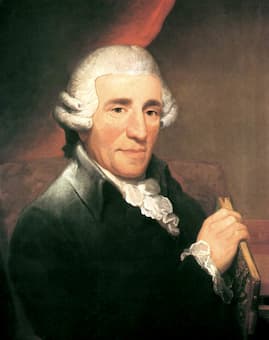
Portrait of Joseph Haydn by Thomas Hardy, 1791
D minor seemed to have been a highly popular key for composing large-scale symphonies. We have symphonies No. 1 by Dohnányi, Ives, Rachmaninoff and Richard Strauss. Prokofiev and Balakirev wrote their 2nd symphonies in D minor, the same key used by Bruckner in his symphonies No. 3 and No. 9. Dvořák composed his symphonies No. 4 and No. 7 in D minor, and there are also symphonies by Schumann, Shostakovich, Sibelius, Vaughan Williams, Glazunov, and of course the monumental symphony No. 9 by Beethoven. Which one is actually my favorite? To tell the truth, I really can’t decide. So I went back to the father of the symphony, Joseph Haydn, and I found a delightful storm and stress symphony in D minor. His 80th symphony probably dates from 1784, and for some reason it does not have a nickname. However, it is a symphonic gem and Haydn showed everybody coming after him what was actually possible in a symphony. And it is for that particular reason that Haydn’s 80th is my representative for symphonies in D minor.
Rachmaninoff: Piano Concerto No. 3 in D minor, Op. 30
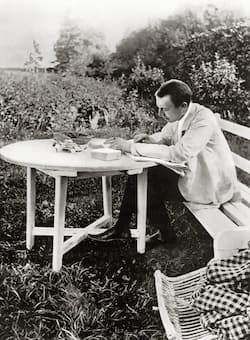
Rachmaninoff proofing a manuscript
Some composers are actually rather difficult to read. Sergei Rachmaninoff was clearly one of the last great pianist-composers in a long tradition stretching back to Mozart, Beethoven, Liszt and Brahms. He proudly suggested that “a composer’s music should express the country of his birth, his love affairs, his religion, the books which have influenced him, and the pictures he loves… My music is the product of my temperament…” Rachmaninoff was fiercely egotistic in artistic matters, but also frequently depressed without any specific cause. Very few people ever heard him laugh, and only occasionally did he crack a rare smile. He was often grave in expression and mannerism, and seemed to have been stuck in prolonged periods of philosophical longing and melancholy. Almost sounds like Rachmaninoff could be considered the poster child for D minor. And wouldn’t you know it, he did write a great number of works in that particular key, including the fabulous 3rd piano concerto. It is without doubt one of the all-time best songs in D minor. As you can tell, the key of D minor was really popular with composers, and I have tried to find my favorite songs; what is yours? Next time, I will take a look at the best songs in the cheerful key of B-flat major.
Tuesday, May 31, 2022
Jacques Ibert - his music and his life
Sunday, May 29, 2022
Germaine Tailleferre - her music and her life
Born in Paris on April 19th 1892, French composer Germaine Tailleferre began her studies at the Paris Conservatory in 1904, despite her father’s opposition and her equal ability in art. She studied primarily with Eva Sautereau-Meyer. She was a pianistic prodigy with a phenomenal memory for music which led to her winning many prizes. In 1913, she met Auris, Honegger and Milhaud whilst studying in Georges Caussade’s counterpoint class. Eric Satie was so impressed by her 1917 work Jeux de plein air for two pianos that he described her as his ‘musical daughter’, and through this relationship, Tailleferre’s reputation was substantially advanced. When Les Six was formed in 1919-20, she became its only female member. Her abilities at the harpsichord and affinity for the styles of music originally composed for the instrument stood her in excellent stead as the neo-classicism of Stravinsky began to grow in popularity, though her works retained an influence of Fauré and Ravel.
Unfortunately, Tailleferre’s circumstances in through much of the rest of her life meant that she never gained much of the same acclaim as the other members of Les Six. After two very unhappy marriages, she found her creative energies drained and due to financial issues was almost unable to compose if not for commission, leading to many uneven and quickly composed works. Moreover, her lack of self-esteem and sense of modesty held her back from publicising herself to a fuller extent. In spite of this, some of concerti of the 1930s saw some success and she was often approached to compose for film. Throughout her career she continued to compose music for children which some writers have suggested helped to retain the spontaneity, freshness and charm that characterises her finest works.
Saturday, May 28, 2022
Darius Milhaud - his music and his life
Darius Milhaud (4 September 1892 – 22 June 1974) was a French composer and teacher. He was a member of 'Les Six' and one of the most prolific composers of the twentieth century. His compositions are influenced by jazz and make use of polytonality.
Milhaud studied at the Paris Conservatory where he met his fellow group members Arthur Honegger and Germaine Tailleferre. Milhaud (like his contemporaries Paul Hindemith, Gian Francesco Malipiero, Bohuslav Martinů and Heitor Villa-Lobos) was an extremely rapid creator, for whom the art of writing music seemed almost as natural as breathing. His most popular works include Le bœuf sur le toit (ballet), La création du monde (a ballet for small orchestra with solo saxophone, influenced by jazz), Scaramouche (for Saxophone and Piano, also for two pianos), and Saudades do Brasil (dance suite).
His autobiography is entitled 'Notes sans musique' (Notes Without Music), later revised as 'Ma vie heureuse' (My Happy Life). The Milhaud family left France in 1939 and emigrated to America in 1940 where he secured a teaching post at Mills College in Oakland, California. From 1947 to 1971 he taught alternate years at Mills and the Paris Conservatoire, until poor health compelled him to retire. He died in Geneva aged 81.
Friday, May 27, 2022
The Greatest Composers of Film Music
Satie, Ibert, Tailleferre, Milhaud and Honegger
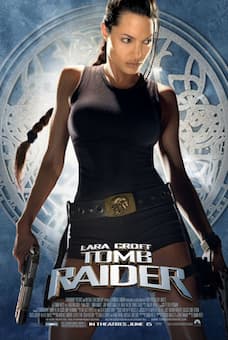
Tomb Raider
I was still too young to actually see the first “Tomb Raider” film release in 2001. But when I first watched it some years later, I thought it was the biggest thing since the invention of the handbag. Finally, there was an empowered women beating up all those macho male characters. Later I played all the video games, and “Lara Croft” became a cultural phenomenon that is still going strong 25 years later. Basically, they are pretty silly movies but you can’t beat swashbuckling action films if you want to enjoy a couple hours of mindless fun. The Hollywood studios have given us countless action/adventure movies, and that formula has been a huge commercial success. No wonder that they called the 1930’s Hollywood’s Golden Age. In Europe meanwhile, audiences had little taste for blowing up the world movies after World War I, so filmmakers tended to focus more on the artistic qualities of film. While American composers of film music “seemingly held that new medium in distain,” they imported the Viennese composers Max Steiner and Wolfgang Eric Korngold. In Europe meanwhile, a significant number of art music composers embraced this new challenge. In France, in particular, a number of big-name composers eagerly adopted the new art form, including Erik Satie, Jacques Ibert, Germaine Tailleferre, Darius Milhaud, and Arthur Honegger.
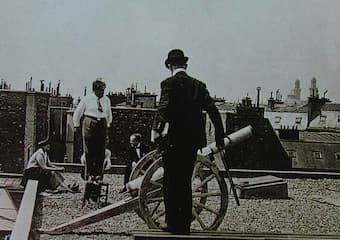
Erik Satie & Francis Picabia, Jean Biorlin (prologue de Relache)
When eccentricity and classical music are used in the same sentence, Erik Satie (1866-1925) immediately comes to mind. Irreverent, disrespectful, contemptuous of tradition, forcefully direct and brutally honest, Satie famously wrote underneath his self-portrait, “I have come into the world very young, into an era very old.” In 1924, Satie collaborated on a ballet production with Francis Picabia, and since both artists had a taste for controversy, audiences immediately knew what to except. It was called Relâche, loosely translated into “No Performance today,” or “Theatre Closed,” and it had really no plot. A female character dances with a changing number of male characters, including a paraplegic in a wheelchair. And there is a man dressed as a fireman who wanders around the stage, pouring water from one bucket into another.
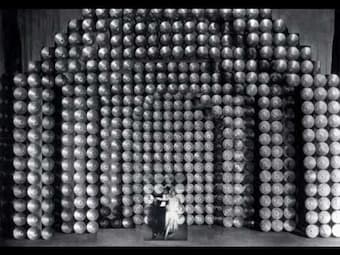
Relâche Part 1
Between acts and after the overture, the film “Entr’acte” was shown. An experimental film by critic Rene Clair, it featured scenes filmed in Paris that included a dancing ballerina with moustache and beard, a hunter shooting a large egg, and a mock funeral procession with a camel-drawn hearse. Satie composed the music for both the ballet and the film, and his score for “Entr’acte” was called revolutionary. “It is an excellent example of early film music, as different segments reflect and support the rhythm of the action and serve as a kind of neutral rhythmic counterpoint to the visual action.” Satie used a number of popular tunes, and while the ballet is little more than nonsensical fragmented spectacle to make Dada proud, “the music is essentially unified and symmetrical.” The premiere, as you might expect, did not go well and audiences and critic attacked “the stupidity of the staging and the inanity of the musical score.” Today we recognize it “as an inventive score without peer, at once durable and distinguished, with “Satie having understood correctly the limitations and possibilities of a photographic narrative as subject matter for music.”
Jacques Ibert: 4 Chansons de Don Quichotte
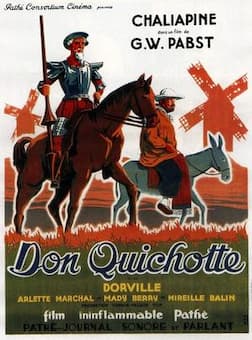
Don Quichotte
I have always loved the music of Jacques Ibert (1890-1962) because he doesn’t take himself or classical music all too seriously. He once said that he only agreed to write music that he was happy to listen to himself. “I want to be free,” he writes, “independent of the prejudices which arbitrarily divide the defenders of a certain tradition, and the partisans of a certain avant garde.” His biographer writes, “Ibert’s music can be festive and gay…lyrical and inspired, or descriptive and evocative…often tinged with gentle humour.” That’s a perfect recipe for writing incidental music for the theater and music for film. In fact, Ibert was a prolific composer when he came to cinema scores, writing music for more than a dozen French films, and two pictures for American directors Orson Welles and Gene Kelly. In 1933, Georg Wilhelm Pabst, one of the most influential German-language filmmakers during the Weimar Republic, directed Don Quixote, the film adaptation of the classic Miguel de Cervantes novel. It was made in three versions—French, English, and German—and featured the famous operatic bass Feodor Chaliapin. The producers separately commissioned five composers—Ibert, Ravel, Delannoy, de Falla, and Milhaud to write the songs for Chaliapin, each composer believing only he had been approached. Jacques Ibert’s music was selected for the film, and Ravel considered a lawsuit against the producers.
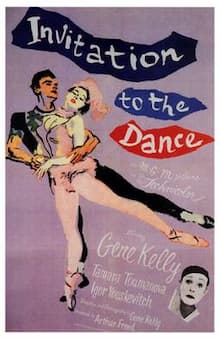
Invitation to the Dance
The American actor, dancer, and singer Eugene Kelly became incredibly famous for his performances in “An American in Paris,” and for “Singin’ in the Rain.” Kelly also starred in “Invitation to the Dance,” the first film he directed on his own. The film is a dance anthology that has no spoken dialogue, with the characters performing their roles entirely through dance and mime. The film consists of three distinct stories, written by Kelly, with the first segment “Circus” set to original music by Jacques Ibert. The plot is a tragic love triangle set in a mythical land sometime in the past. Kelly plays a clown, who is in love with another circus performer, played by Claire Sombert. She, however, is in love with an Aerialist, played by Youskevitch. The Clown, after entertaining the crowds with the other clowns, sees his love and the Aerialist kiss and wanders into a crowd in shock. That night he watches them dance together, and after the Lady finds him with her shawl, he confesses his love to her. The Aerialist finds them and thinks she has been unfaithful and leaves her. Determined to win her, the Clown tries to walk the Aerialist’s tightrope himself, only to fall to his death. Dying, he urges the two lovers to forgive each other. By the way, the movie was a colossal failure at the box office, but it is today regarded “as a landmark all-dance film.”
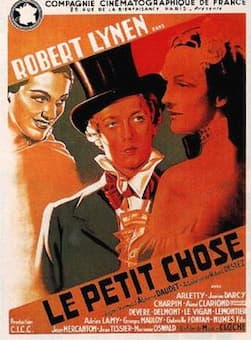
Le petit chose
Germaine Tailleferre (1892-1983) was the only female member of the French group of composers known as “Les Six.” She was well-known for her intimate chamber music compositions, but it is generally less well-known that she scored music for thirty-eight films! And that includes music for a series of documentaries, and a number of wonderful collaborations with film director and producer Maurice Cloche. His career spanned for over a half-century, and he produced spy thrillers and films with religious and social themes. He is probably best known for “La Cage aux Oiseaux” (‘The Bird Cage); “Le Docteur Laennec,” the story of the inventor of the stethoscope; “Ne de Pere Inconnu” (Father Unknown) and “La Cage aux Filles” (The Girl Cage). Cloche founded a film society for young talents in 1940, which later became the Institute of Advanced Film Studies and France’s leading film school. Cloche was part of a group of directors that focused on poetic realism, but he did not neglect social subjects. His most famous documentaries on art included “Terre d’amour,” “Symphonie graphique,” “Alsace,” and “Franche-Comte.” In 1938 Cloche turned the autobiographical memoir by Alphonse Daudet into the film Le Petit Chose (Little Good-for-Nothing) starring Arletty, Marianne Oswald, and Marcelle Barry. The title is taken from the author’s nickname, and “Little Good-for-Nothing” is forced to accept a job as a Latin teacher in a college. He is expelled for having naively trusted one of his colleagues, and he departs to join his brother in Paris where he is dreaming of great literary career. As an interesting side-note, the movie features 14-year-old classical guitarist Ida Presti in a supporting role as a guitar player. Tailleferre composed a wonderfully flowing film store that is at once “bold and original, dissonant and exploratory, vigorous and soothing.” In her day, Tailleferre was greatly admired for her film work, which was “likened to the wispy work of the popular watercolorist Marie Laurencin.”
Darius Milhaud: L’album de Madame Bovary
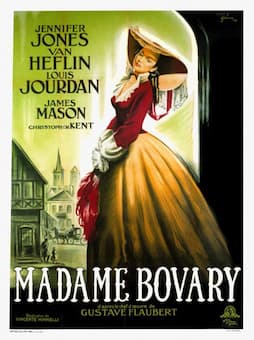
Madame Bovary
Darius Milhaud (1892-1974) composed over 400 compositions during his life, and given his love of the cinema, he also wrote music for 25 films. It all started with his first major success, the 1919 Surrealist ballet “Le Boeuf sur le toit,” (The Ox on the Roof). That work was originally subtitled a “Cinéma-symphonie,” and it featured fifteen minutes of music “rapid and gay, as a background to any Charlie Chaplin silent movie.” Milhaud was already composing music in the silent era, “with the now lost score to accompany Marcel L’Herbier’s avant-garde melodrama “L’Inhumaine.” The music is said to have matched the “film’s abrupt, expressionist rhythm, climaxing—for a scene where the hero resurrects his dead love in a futuristic laboratory—in a bravura cadenza scored solely for percussion instruments.” Always eager to experiment, Milhaud brought the opera into the cinema, as he used a backdrop movie screen to disclose the thoughts of his characters in his opera Christophe Colombe. In Dreams That Money Can Buy of 1947, Milhaud collaborated with the Surrealist/Dada super stars Max Ernst, Marcel Duchamp, Man Ray, Alexander Calder, and Fernand Léger, and he received a visit from Renoir while he was composing the score for Madame Bovary.
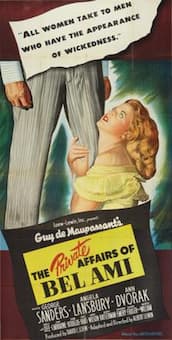
The Private Affairs of Bel Ami
Milhaud’s love for experimentation needed an eclectic use of music. He did admire Debussy and Mussorgsky but truly hated Wagner. Milhaud “happily threw in elements of whatever took his fancy—jazz, Brazilian dance rhythms, the medieval troubadour songs of his native Provence. Rather than cast his music in a predetermined style, he preferred to adopt whatever forms and materials seemed appropriate to the given task. This adaptability, together with his fluency of inspiration should have made him an ideal film composer. But his relationship with the movie industry remained oddly uneasy.” Milhaud spent much of his later life in America, but hated working for Hollywood. “He disliking the system of handing over the composer’s short score to professional orchestrators who churn out on a commercial scale musical pathos à la Wagner or Tchaikovsky.” He did, however, accept one Hollywood assignment titled The Private Affairs of Bel-Ami directed by Albert Lewin. Milhaud called him a “highly cultured man, and what is even rarer in those circles, genuinely modest.” Milhaud did orchestrate his own music, conducted the recording session and was present during the mixing. “The result was a score that vividly evoked the Paris of the Belle Epoque, but without the usual wash of romantic nostalgia.”
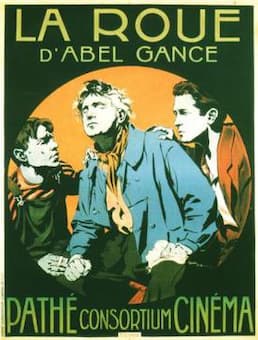
La Roue
Arthur Honegger (1892-1955) was critically acclaimed for both his concert music and his film scores during the interwar years in France. In terms of film scoring, Honegger is best remembered for his collaboration with Abel Gance, a pioneer film director, producer, writer and actor. Gance pioneered the theory and practice of montage, and he is best known for three major silent films J’accuse (1919), La Roue (1923), and Napoléon (1927). And Honegger wrote the music for all three silent films. J’accuse juxtaposes a romantic drama with the background of the horrors of World War I, and it is sometimes described as a pacifist or anti-war film. Work on the film began in 1918, and some scenes were filmed on real battlefields; can you imagine? The film’s powerful depiction of wartime suffering, and particularly its climactic sequence of the “return of the dead” made it an international success, and confirmed Gance as one of the most important directors in Europe. The only surviving score for the 1922 melodrama La Roue is an overture scored for medium-sized orchestra. There has been much speculation as to the rest of the music, and it is said “that Honegger put together a score consisting of pieces of his own and music from the classical repertoire.”
Arthur Honegger: Napoleon Suite
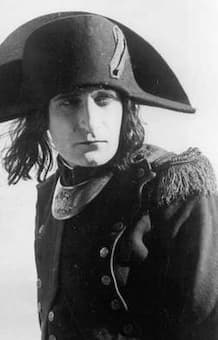
Albert Dieudonne as Napoleon_1927
Abel Gance’s silent masterpiece Napoleon of 1927 “exceeds the parameters of virtually every aspect of film culture. In the 1920s, its temporal gigantism horrified producers and its aesthetic invention flustered critics.” The film is recognised as a “masterwork of fluid camera motion, produced in a time when most camera shots were static. Many innovative techniques were used to make the film, including fast cutting, extensive close-ups, a wide variety of hand-held camera shots, location shooting, point of view shots, multiple-camera setups, multiple exposure, superimposition, underwater camera, kaleidoscopic images, film tinting, split screen and mosaic shots, multi-screen projection, and other visual effects.” It tells the story of Napoleon’s early years, and Gance had planned it to be the first of six films about Napoleon’s career, basically a chronology of great triumph and defeat ending in Napoleon’s death in exile on the island of Saint Helena.
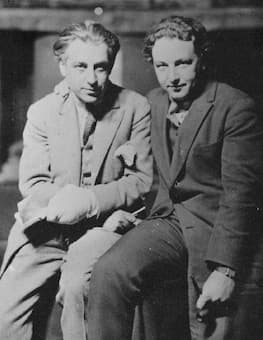
Abel Gance and Arthur Honegger, 1926
Gance had struggled to make the first film, and given the enormous costs involved, he understood that the full project was impossible. Honegger believed that “cinematic montage differs from musical composition in that, while the latter depends on continuity and logical development, the film relies on contrasts. Music and sound must, therefore, adapt themselves to strengthening and complementing the visual element, while the whole must be an artistic unity.” Until now, the original cue sheet for Honegger’s music to Napoleon has not been found, so we don’t know exactly what music was played when. However, a number of musical autographs and orchestrated manuscripts have survived, and have been compiled into a wonderful Napoleon Suite sequence. There are so many more beautiful French movies and corresponding gorgeous music to explore, but in the next blog we will turn our attention to the two Russian giants Dmitri Shostakovich and Sergei Prokofiev.
Thursday, May 26, 2022
Britain’s Got Talent opera singer performs ‘Caruso’ and moves audience to tears
24 May 2022, 16:42 | Updated: 25 May 2022, 14:06
By Savannah Roberts, ClassicFM London
Here's the moment a young opera singer delivered a 1986 Italian love song famously performed by the likes of Luciano Pavarotti and Andrea Bocelli.
Maxwell Thorpe gave a hair-raising performance during his Britain’s Got Talent audition, surprising the crowd with the challenging number written by Lucio Dalla and dedicated to the prolific operatic tenor, Enrico Caruso.
Introducing his performance, the 32-year-old opera singer told the judging panel that he was “very nervous”.
“I’ll have to sing them [my nerves] out,” the northern singer announced to the audience.
Maxwell revealed that he had been busking in Sheffield for 10 years, and that in his experience he is “sometimes singing to people that aren’t listening.”
Read more: Incredible moment when ‘The X Factor’ vocalist sang both parts in soprano and tenor duet

The judges and audience were left stunned when Thorpe’s shy demeanour dropped, as soon as he began to sing. A moment of silence fell upon the stage as the melancholic melody came to a close, before the theatre responded with a well-earned standing ovation.
Simon Cowell showered the BGT hopeful with praise, saying: “You’re heading for the big time. Maxwell, that was extraordinary. Seriously, you’re so shy and quiet and then that happened.
“I thought that made it incredible,” Simon continued.
The reaction among the panel was unanimous, with Alesha Dixon professing: “Wow, wow, wow! The hairs on my arms stood up, literally as soon as you started.
Read more: When a 13-year-old operatic soprano stormed America’s Got Talent finals, and ignited a huge debate

“It just felt romantic and powerful and meaningful and all the feels.”
Amanda Holden praised the Sheffield singer further, saying: “I hope that going forward you feel more appreciated because these people were on their feet for you. I really hope that reaction has done something for your confidence as you are better than standing on a pavement.”
Maxwell received a yes from all four judges, who turned around in their seats to see an ecstatic audience behind them. Opera on a talent show? We’ve seen it before, but this is up there with the best...




